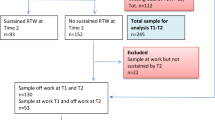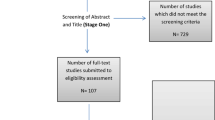Abstract
Purpose Organizational-level policies and practices that promote safety leadership and practices, disability management and ergonomic policies and practices are considered key contextual determinants of return to work. Our objective was to examine the role of worker-reported organizational policies and practices (OPPs) in return to work (RTW) and work role functioning (WRF) and the mediating role of pain self-efficacy and work accommodation. Methods A worker cohort (n = 577) in Ontario, Canada was followed at 1, 6 and 12 months post injury. Both RTW (yes/no) and WRF (WLQ-16) status (3 levels) were measured. OPPs were measured (high vs. low) at 1 month post-injury. Pain self-efficacy (PSE) and work accommodation (WA) were included in mediation analyses. Results OPPs predicted RTW at 6 months (adjusted OR 1.77; 95 % CI 1.07–2.93) and 12 months (adjusted OR 2.07; 95 % CI 1.18–3.62). OPPs predicted WRF at 6 months, but only the transition from working with limitations to working without limitations (adjusted OR 3.21; 95 % CI 1.92–5.39). At 12 months, OPPs predicted both the transition from not working to working with and without limitations and from not working or working with limitations to working without limitations (adjusted OR 2.13; 95 % CI 1.37–3.30). Offers of WA mediated the relationship between OPPs and both RTW and WRF at 6 months follow-up. PSE mediated the relationship between OPPs and RTW and WRF at 6 months. At 12 months neither mediated the relationship. Conclusions The findings support worker-reported OPPs as key determinants of both RTW and WRF. These results point to the importance of WA and PSE in both RTW and WRF at 6 months.
Similar content being viewed by others
References
Brewer S, King E, Amick B, Delclos G, Spear J, Irvin E, Mahood Q, Lee L, Lewis C, Tetrick L, Gimeno D, Williams R. A systematic review of injury/illness prevention and loss control programs (IPC). Toronto: Institute for Work & Health; 2007.
Van Oostrom SH, Driessen MT, de Vet HCW, Franche, R-L, Schonstein E, Loisel P, et al. Workplace interventions for preventing work disability. Cochrane Database Syst Rev 2009.
Gensby U, Labriola M, Irvin E, Amick BC, Lund T. A classification of components of workplace disability management programs: results from a systematic review. J Occup Rehabil. 2014;24:220–41.
Habeck RV, Hunt HA, VanTol B. Work-place factors associated with preventing and managing work disability. Rehabil Counsel Bull. 1998;42:98–143.
Amick BC III, Habeck RV, Hunt A, Fossel AH, Chapin A, Keller RB, Katz JN. Measuring the impact of organizational behaviors on work disability prevention and management. J Occup Rehabil. 2000;10:21–38.
Ossmann J, Amick BC III, Habeck RV, Hunt A, Ramamurthhy G, Soucie V, Katz JN. Management and employee agreement on reports of organizational policies and practices important in return to work following carpal tunnel surgery. J Occup Rehabil. 2005;15:17–26.
Williams RM, Westmorland MG, Shannon H, Rasheed F, Amick BC III. Disability management practices in education, hotel/motel and health care workplaces. Am J Ind Med. 2005;47:217–26.
Williams RM, Westmorland MG, Shannon HS, Amick BC III. Disability management practices in Ontario health care workplaces. J Occup Rehabil. 2007;17:153–65.
Cullen KL, Williams RM, Shannon HS, Wessel J, Amick BC III, Westmoreland MG. Workplace disability management practices in Ontario educational facilities. J Occup Rehabil. 2005;15:417–33.
Tveito TH, Sembajwe G, Boden LI, Dennerlein JT, Wagner GR, Kenwood C, Stoddard AM, Reme SE, Hopcia K, Hashimoto D, Shaw WS, Sorensen G. Impact of organizational policies and practices on workplace injuries in a hospital setting. J Occup Environ Med. 2014;56:802–8.
Tang K, MacDermid JC, Amick BC, Beaton DE. The 11-item workplace organizational policies and practices questionnaire (OPP-11): examination of its construct validity, factor structure, and predictive validity in injured workers with upper-limb disorders. Am J Ind Med. 2011;54:834–46.
Amick BC III, Habeck RV, Ossmann J, Fossel AH, Keller R, Katz JN. Predictors of successful work role functioning after carpal tunnel release surgery. J Occup Environ Med. 2004;46:490–500.
Katz JN, Amick BC III, Keller R, Fossel AH, Ossmann J, Soucie V, Losina E. Determinants of work absence following surgery for carpal tunnel syndrome. Am J Ind Med. 2005;47:120–30.
Franche R-L, Severin C, Hogg-Johnson S, Lee H, Côté P, Krause N. A multivariate analysis of factors associated with offer and acceptance of a work accommodation following an occupational musculoskeletal injury. J Occup Environ Med. 2009;51:969–83.
Franche R-L, Cullen K, Clarke J, Irvin E, Sinclair S, Frank J, et al. Workplace-based return-to-work interventions: a systematic review of the quantitative literature. J Occup Rehabil. 2005;15:607–31.
Franche R-L, Severin C, Hogg-Johnson S, Côté P, Vidmar M, Lee H. The impact of early workplace-based return-to-work strategies on work absence duration: a 6-month longitudinal study following an occupational musculoskeletal injury. J Occup Environ Med. 2007;49:960–74.
Krause N, Dasinger LK, et al. Modified work and return to work: a review of the literature. J Occup Rehabil. 1998;8:113–39.
Brooker A-S, Cole DC, Hogg-Johnson S, Smith J, Frank JW. Modified work: prevalence and characteristics in a sample of workers with soft-tissue injuries. J Occup Eviron Med. 2001;43:276–84.
Busch H, Göransson S, Melin B. Self-efficacy beliefs predict sustained long-term sick absenteeism in individuals with chronic musculoskeletal pain. Pain Pract. 2007;7:234–40.
Amick BC III, Lerner DJ, Rogers WH, Rooney T, Katz Jeffrey N. A review of health-related work outcome measures and their uses, and recommended measures. Spine. 2000;25:3152–60.
Wasiak R, Young AE, et al. Measuring return to work. J Occup Rehabil. 2007;17:766–81.
Bültmann U, Franche RL, Hogg-Johnson S, Côté P, Lee H, Severin C, Vidmar M, Carnide N. Health status, work limitations, and return-to-work trajectories in injured workers with musculoskeletal disorders. Qual Life Res. 2007;16:1167–78.
Lerner DJ, Amick BC III, Rogers WH, Malspeis S, Bungay K, Cynn D. The work limitations questionnaire. Med Care. 2001;39:72–85.
Lerner DJ, Amick BC III, Lee J, Rooney T, Rogers WH, Chang H, Berndt ER. The relationship of employee-reported work limitations to work productivity. Med Care. 2003;41:649–59.
Brouwer S, Franche RL, Hogg-Johnson S, Lee H, Krause N, Shaw WS. Return-to-work self-efficacy: development and validation of a scale in claimants with musculoskeletal disorders. J Occup Rehabil. 2011;2:244–58.
Brouwer S, Amick BC III, Lee H, Franche RL, Hogg-Johnson S. The predictive validity of the return-to-work self-efficacy scale for return-to-work outcomes in claimants with musculoskeletal disorders. J Occup Rehabil. 2015;25:725–32.
Shaw WS, Huang YH. Concerns and expectations about returning to work with low back pain: identifying themes from focus groups and semi-structured interviews. Disabil Rehabil. 2005;27:1269–81.
Jaroszynski G, Cassidy JD, Côté P, Carroll L, Yong-Hing H. Development, reliability, and concurrent validity of a new self-assessed comorbidity scale. Unpublished manuscript, University of Saskatchewan (1998).
Von Korff M, Jensen MP, Karoly P. Assessing global pain severity by self-report in clinical and health services research. Spine. 2000;25:3140–51.
Beaton DE, Wright JG, Katz JN, The Upper Extremity Collaborative Group. Development of the QuickDASH: comparison of three item-reduction approaches. J Bone Joint Surg Am. 2005;87:1038–46.
Roland M, Morris R. A study of the natural history of back pain. Part I: development of a reliable and sensitive measure of disability in low-back pain. Spine. 1983;8:141–4.
Ware J, Kosinski M, Keller SD. A 12-item short-form health survey: construction of scales and preliminary tests of reliability and validity. Med Care. 1996;34:220–33.
Ware J, Kosinski M, Keller SD. SF-12: how to score the SF-12 physical and mental health summary scales. Lincoln: Quality Metric Incorporated; 2002.
Radloff LS. The CES-D scale: a self-report depression scale for research in the general population. Appl Psychol Meas. 1977;1:385–401.
Stokes ME, Davis CS, Koch GG. Categorical data analysis using the SAS system. 2nd ed. Cary: SAS Institute Inc.; 2000.
MacKinnon DP. Introduction to statistical mediation analysis. New York: Lawrence Erlbaum Associates; 2008.
Anema JR, Steenstra IA, Bongers PM, de Vet HC, Knol DL, Loisel P, van Mechelen W. Multidisciplinary rehabilitation for subacute low back pain: graded activity or workplace intervention or both?: a randomized controlled trial. Spine. 2007;32:291–8.
Lambeek LC, van Mechelen W, Knol DL, Loisel P, Anema JR. Randomised controlled trial of integrated care to reduce disability from chronic low back pain in working and private life. BMJ. 2010;340:c1035.
Loisel P, Abenhaim L, Durand P, Esdaile JM, Suissa S, Gosselin L, Simard R, Turcotte J, Lemaire J. A population-based, randomized clinical trial on back pain management. Spine. 1997;22:2911–8.
Schreurs B, van Emmerik H, Notelaers G, De Witte H. Job insecurity and employee health: the buffering potential of job control and job self-efficacy. Work Stress. 2010;24:56–72.
Schaubroeck J, Lam SSK, Xie JL. Collective efficacy versus self-efficacy in coping responses to stressors and control: a cross-cultural study. J Appl Psychol. 2000;85:512–25.
Xanthopoulou D, Bakker A, Demerouti E, Schaufeli WB. The role of personal resources in the job demands-resources model. Int J Stress Manag. 2007;14:121–41.
Bandura A. Health promotion from the perspective of social cognitive theory. Psychol Health. 1998;13:623–49.
Bandura A. Self-efficacy: the exercise of control. New York: W. H. Freeman; 1997.
Franche R-L, Krause N. Readiness for return to work following injury or illness: conceptualizing the interpersonal impact of healthcare, workplace, and insurance factors. J Occup Rehabil. 2002;12:233–56.
Acknowledgments
The development of the Readiness for Return to Work Cohort was supported by Grants (#6021, #4010) from the Workplace Safety and Insurance Board. All authors were involved in either the conception and design or the analysis and interpretation of data, in the drafting of the article, and in the final approval.
Author information
Authors and Affiliations
Corresponding author
Ethics declarations
Conflict of Interest
The authors declare they have no conflicts of interest.
Electronic supplementary material
Below is the link to the electronic supplementary material.
Rights and permissions
About this article
Cite this article
Amick, B.C., Lee, H., Hogg-Johnson, S. et al. How Do Organizational Policies and Practices Affect Return to Work and Work Role Functioning Following a Musculoskeletal Injury?. J Occup Rehabil 27, 393–404 (2017). https://doi.org/10.1007/s10926-016-9668-8
Published:
Issue Date:
DOI: https://doi.org/10.1007/s10926-016-9668-8




